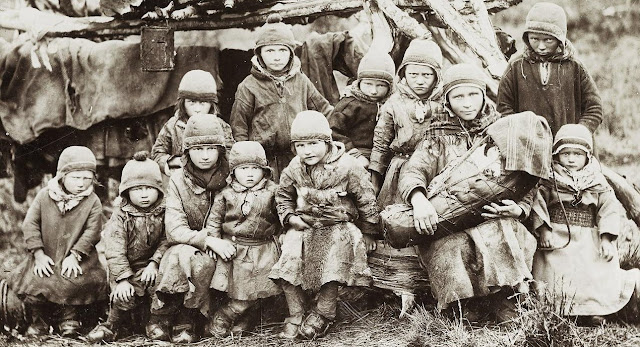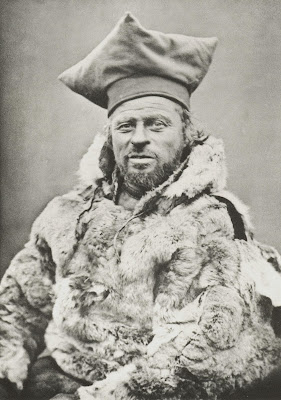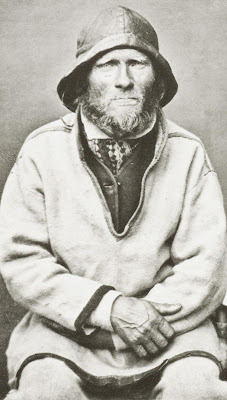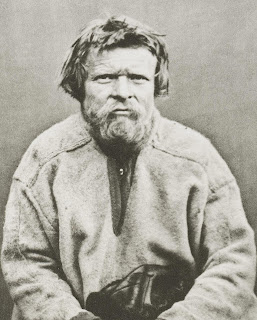 Photo postcard by Algård from 1930ies: Children from a Nomad school in Gällivare.
Photo postcard by Algård from 1930ies: Children from a Nomad school in Gällivare. The two female haplogroups U5 and V that are observed in nearly 90% of the Saami women (Tambets et al. 2004) are found to be of northern European origin (Kivisild et al. 2006). Both of these female genetic groups and male haplogroup I1a (M253) very likely have over-wintered in Iberia or areas close to Iberia during the Last Ice Age (Torroni et al. 2001, Tambets et al.2004, Achilli et al. 2005) before they migrated northwards.
New article about mtDNA U5 - Ny artikkel om mtDNA U5 April 2010: The Peopling of Europe from the Mitochondrial Haplogroup U5 Perspective
Funn viser at de to kvinnelige haplogruppene U5 og V som er observert hos bortimot 90% av alle samiske kvinner (Tambets et al. 2004) er av nordeuropeisk opprinnelse (Kivisild et al. 2006). Begge disse kvinnelige genetiske gruppene og den mannlige haplogruppen I1a (M253) overvintret svært sannsynlig i Iberia eller områder i nærheten av Iberia i løpet av den siste istiden (Torroni et al. 2001, Tambets et al.2004, Achilli et al. 2005) før de migrerte nordover.

ARCTIC SHORE, Barents Sea © Abanamath Dreamstime.com © Photographer:Eugeny Shevchenko Agency: Dreamstime.com Click on the photo to see a higher resolution image.
 Photo Courtesy NASA JPL-Caltech.
Photo Courtesy NASA JPL-Caltech.The present Saami is a mixture of different people with similar cultures, Finno-Ugric language and nine different dialects in all Nordic countries and at the Kola Peninsula. In this blog-context the definition of “Saami” is made in relation to genetic haplogroups. The reason why I define “Saami” like this is because of the accumulation of old and cold adapted genetic haplogroups (See Kivisild et al. 2006) in the present Saami populations (mtDNA U5 and V and yDNA I1a). The Saami ancestors very likely migrated northwards belonging to the first European hunter and gatherer populations. Because of the harsh climate and other factors these hunter and gatherers seem to have been isolated and with a low mobility for a long period of time back in history. The cultures of the Saami were similar in large geographical areas, here called "the historical Saami areas". The historical Saami areas seem to have included all of the Scandinavian and Kola Peninsulas, all of Finland (the name means the land of the Saami), parts of Karelia (where old religious Saami stone monuments such as Vottovaara have been found).
According to Nina Lavonen there still are old Saami topographical names in Karelia such as Lapinsaari, Lapinniemi, Lapinlampi. Lavonen writes that it is well known and supported with archaeological findings (e.g. archaeologist J. W. Juvelius) that the Saami lived in the present areas of Karelia long before Karelians and Russians.
The much larger historical Saami areas possible stretched as far south and east as Estonia where there still today are a small Saami population (Eesti Saami).
Dagens Samer er en smeltedigel av ulike folk med like kulturer, finsk-ugrisk språk og ni ulike dialekter i alle nordiske land og på Kolahalvøya. I denne blogg-konteksten er definisjon av “Samisk” gjort i forhold til genetiske haplogrupper. Grunnen til at jeg definerer ”Samisk” på denne måten er den høye konsentrasjonen av gamle og kuldetilpassede genetiske haplogrupper (se Kivisild et al. 2006) i dagens samiske befolking (mtDNA U5 og V and yDNA I1a). Samenes forfedre og formødre migrerte svært sannsynlig nordover som en del av de første europeiske jeger- og samlerfolkene. På grunn av det harde klimaet og andre faktorer var disse jeger- og samlere isolert og lite mobile i en lang periode tilbake i historien. De samiske kulturene ser ut til å ha liknet hverandre i store geografiske områder, områder jeg her kaller "de historiske samiske områdene". De historiske samiske områdene inkluderte svært sannsynlig hele den Skandinaviske og Kolahalvøya, hele Finland (navnet betyr samenes land), deler av Karelen (hvor man har funnet gamle religiøse samiske stein monumenter slik som Vottovaara).
I følge Nina Lavonen er det i Karelen fremdeles gamle samiske stedsnavn slik som Lapinsaari, Lapinniemi og Lapinlampi. Lavonen skriver at det er velkjent og støttet med arkeologiske funn (for eksempel av arkeologen J.W. Juvelius) at samene levde i de nåværende områdene av Karelia lenge før Karelere og Russere.
Det historiske samiske området kan ha strukket seg så langt sør som til Estland hvor det fremdeles i dag finnes en liten samisk befolkning (Eesti Saami).
 Photo is a postcard from 1903: The Saami girl Lisa Thomasson.
Photo is a postcard from 1903: The Saami girl Lisa Thomasson. The Saami ancestors moved into the icy Nordic areas where they developed a specific U5b motifs often called “The Saami motif”. As you can see from the frequency table under the present Saami populations have extreme frequencies of U5b1, also called U5b1b1 and is defined by mutations [16144, 16189, 16270]. Additionally the present Saami have extreme frequencies of mtDNA haplogroup V. MtDNA V is defined by mutation 16298. Saami MtDNA V ancestors very likely came with other and somewhat later migrations northwards than the U5b people (Delghandi et al.1998). There are exclusive Saami mtDNA V lineages, see for instance the research reports by Tambets et al. (2004) and Torroni et al.(2001).
De samiske formødrene oppholdt seg i de iskalde nordiske områdene hvor de utviklet et spesifikt U5b motiv som ofte kalles ”det samiske motiv”. Som du kan se i frekvenstabellen under så har dagens samiske populasjoner ekstreme frekvenser av U5b1, som også er kalt U5b1b1, og er definert av mutasjonene [16144, 16189, 16270]. I tillegg har dagens samer ekstreme frekvenser av mtDNA haplogruppe V. MtDNA V er definert av mutasjonen 16298. De samiske formødrene til mtDNA V kom svært sannsynlig med andre og senere migrasjoner nordover enn U5b folkene (Delghandi et al.1998). Det finnes spesielle samiske mtDNA V haplotyper, se for eksempel i forskningsrapportene til Tambets et al.(2004) og Torroni et al.(2001).
In a new study Kivisild et al. (2006) supported that mtDNA haplogroup V is of northern European origin, but somewhat younger than the other cold adapted northern European haplogroup U5. The HV founder motif of V and H is estimated to be between 22000 – 10000 years old in Europe. An interesting finding in this study is that haplogroup V and the much younger haplogroup H1 (9000 – 5000 years BP) have adapted differently according to dissimilar climate exposures. MtDNA H1 is the most frequent haplogroup in the present Nordic populations. The bearers of mtDNA haplogroup V adapted to the cold northern European climates by processing amino acids like Threonine and Valine differently than the younger H1. MtDNA H1 bearers that developed in warmer climates of the Middle East and in Southern Europe (read page 9-10 in Kivisild et al. 2006) are not cold adapted and therefore very unlikely were present in Europe during the Last Ice Age. I will return to H1 and other mtDNA haplogroups when writing about newer historical migrations to the Nordic areas.
I et nytt studie fant Kivisild et al. (2006) støtte for at mtDNA haplogruppe V er av nordeuropeisk opprinnelse, men er noe yngre enn den andre kuldetilpassede nordeuropeiske haplogruppen U5. Grunnmotivet til V og H kalles HV og dette grunnmotivet har en estimert alder mellom 22000 – 10000 år i Europa. Et interessant funn i dette studiet er at haplogruppe V og den mye yngre haplogruppen H1 (9000-5000 år gammel) har tilpasset seg ulikt på grunn av ulike klimatiske eksponeringer. MtDNA H1 er den mest frekvente haplogruppen i dagens nordiske befolkninger. De som har mtDNA haplogruppe V tilpasset seg det kalde nordeuropeiske klimaet ved å prosessere aminosyrene Threonine og Valine ulikt i forhold til den yngre haplogruppen H1. De som har haplogruppe H1 utviklet seg i varmere klima i Midtøsten og i Sør-Europa (les side 9 –10 i artikkelen til Kivisild et al. 2006). H1 er ikke kuldetilpasset og var derfor lite sannsynlig tilstede i Europa i løpet av den siste istiden. Jeg vil komme tilbake til H1 og andre mtDNA haplogrupper i forbindelse med historisk sett nyere migrasjoner til de nordiske områdene.
As mentioned in Tambets et al. (2004) the people of the old Ahrensburgian migrations along the Norwegian coastal line might be the ancestors of the U5 in the Saami. The other high frequent haplogroup V in the Saami might be descendants of the somewhat younger Mesolithic post-Swiderian cultures that later became the Komsa culture, and that migrated via western Russia, Karelia and Finland. These are theories that are interesting points of departure when trying to understand the western origins of the Saami. In future blog postings I will write about the much more recent eastern migrations to some of the Saami areas.
Som nevnt i artikkelen til Tambets et al.(2004) kan migrasjonen av folk med den gamle Ahrensburg-kulturen langs norskekysten være formødrene til U5 hos dagens samer. Den andre høyfrekvente samiske haplogruppen V kan være etterkommere av en noe yngre Mesolittisk ”post-Swiderian” kultur som senere ble til Komsakulturen, og som migrerte nordover via vest Russland, Karelen og Finland. Disse teoriene er interessante som utgangspunkt for å forstå samenes vestlige opprinnelse. I fremtidige innlegg i denne bloggen skal jeg også skrive om de historisk mye senere migrasjoner fra øst til noen av de samiske områdene.
 Photo is a porstcard from the beginning of 1900eds, Swedish Lappland.
Photo is a porstcard from the beginning of 1900eds, Swedish Lappland.TABLE OF FEMALE HAPLOGROUPS IN THE SAAMI - Tabell med kvinnelige samiske haplogrupper
Table that shows frequencies of eight population genetic haplogroups in different Saami samples. Click on the sample names or numbers in the table to read the research source reports and on the haplogroup names to see migration maps from The Genographic Project Atlas.
Tabellen viser frekvensene til åtte ulike populasjonsgenetiske haplogrupper i ulike samiske befolkninger. Klikk på utvalgsnavnet (Sample) eller numrene i tabellen for å lese forskningsrapportene som er brukt som kilder og på navnet til haplogruppene for å se migrasjonskart fra "The Genographic Project Atlas".
| U5a | U5b | U5b1 | V | Z | H | D5 | W | |
|---|---|---|---|---|---|---|---|---|
| Total Saami | - | - | 56.9 | 31.5 | - | 3.6 | 4.7 | - |
| Kautokeino Norway | - | - | 76.0 | 22.6 | - | - | - | - |
| Karasjok Norway | - | - | 51.3 | 39.7 | - | 3.9 | 3.2 | - |
| North Norway Coast | - | - | 39.1 | 26.1 | - | 17.4 | 8.7 | - |
| Finland | - | - | 50.0 | 9.1 | - | - | 27.3 | - |
| Norwegian | - | 56.8 | 56.8 | 33.1 | 0.0 | 4.7 | 27.3 | 1.4 |
| Finland | - | 40.6 | 40.6 | 37.7 | 7.2 | 2.9 | 8.7 | 0.0 |
| North Swedish | - | 35.5 | 35.5 | 58.6 | 0.7 | 2.6 | 0.0 | 2.0 |
| South Swedish | - | 18.8 | 15.9 | 18.1 | 4.3 | 34.8 | 0.0 | 1.4 |
| South Swedish Trad. | - | 23.9 | 23.9 | 37.0 | 10.9 | 15.2 | 0.0 | 2.2 |
| South Swedish non-trad. | - | 16.3 | 12.0 | 8.7 | 1.1 | 44.6 | 0.0 | 1.1 |
| Saami Total | - | - | 37.4 | 46.1 | - | - | - | - |
| Enare Finland | - | - | 31.8 | 9.1 | - | - | - | - |
| Skolt Finland | - | - | 36.2 | 59.6 | - | - | - | - |
| Norrbotten Sweden | - | - | 32.0 | 60.0 | - | - | - | - |
| Karasjok Norway | - | - | 52.0 | 38.1 | - | - | - | - |
| Skolt Saami | - | - | - | 52.0 | - | - | - | - |
| Enare Finland | - | - | - | 7.1 | - | - | - | - |
| Total Saami | - | - | 47.6 | 41.6 | 1.3 | 2.5 | 3.1 | - |
| Swedish Saami | 0.0 | 26.5 | - | 68.4 | 1.0 | 3.1 | 0.0 | 1.0 |
| Finnish Saami | 2.9 | 40.6 | - | 37.7 | 7.2 | 2.9 | 8.7 | 0.0 |
| Norway Saami | 0.7 | 56.8 | - | 33.1 | 0.0 | 4.7 | 2.9 | 1.4 |
 Photo is a postcard by T. Danilöf, Kiruna. Nomad school near Vaisaluokta in the 1930ies. Click on the photo for a much higher resolution
Photo is a postcard by T. Danilöf, Kiruna. Nomad school near Vaisaluokta in the 1930ies. Click on the photo for a much higher resolution Photo: Bergström, "Nomadskola in Norrbotten" © Västerbottensmuseum
Photo: Bergström, "Nomadskola in Norrbotten" © VästerbottensmuseumMänniskor i norr– People of the North, Bild Museet Umeå Universitetet
The population-genetic Saami U5 founder motif [16144, 16189, 16270] is observed in low percentages outside the Nordic areas and the Kola Peninsula, such as in Karelia 6%, Northern Russia 3%, Lithuania 2.2% and very low frequent in a few other places (Tambets et al. 2004). Another study observed the Saami motif in 0.5% in Poland and 1.5% Russians (Malyarchuk et al. 2002).
Haplogroup V defined by [16153, 16298] is a line observed in the Saami and this line is observed in less than 1% of Polish people, 1% Russians and 2.6% from Finland. Defined solely by 16298 mtDNA V is observed in 21% of the Polish and 11% of Russians (Malyarchuk et al. 2002).
Low frequent observations of the Saami haplotypes outside the Nordic areas can be explained as more recent migrations from the Saami to these areas. With a long-lasting presence in Europe and in the course of thousands of years the Saami genes have spread somewhat, but not much. You can read more in the following article: Richards et al. 2000
Det samiske populasjonsgenetiske grunnmotivet [16144, 16189, 16270] er observert i lave frekvenser utenfor de nordiske områdene og Kolahalvøya, for eksempel 6% i Karelen, 3% i Nord- Russland, 2.2% i Litauen og i svært lave frekvenser noen få andre steder (Tambets et al. 2004). Et annet studie observerte det samiske motivet hos 0.5% i Polen og 1.5% i Russland (Malyarchuk et al. 2002).
Haplogruppe V definert av [16153, 16298] er en av linjene observert hos samene og denne er observert i mindre enn 1% i Polen, 1% i Russland og 2.5% i den generelle finske befolkningen. Definert kun av 16298 er mtDNA V observert hos 21% i Polen og 11% i Russland (Malyarchuk et al. 2002).
Lavfrekvente observasjoner av de samiske haplotypene utenfor Norden kan forklares som nyere migrasjon fra samene til disse områdene. Med en langvarig tilstedeværelse i Europa og i løpet av tusenvis av år har de samiske genene spredt seg noe, men ikke mye. Du kan lese mer om dette blant annet i følgende artikkel: Richards et al. 2000
As shown in the table there are a few lower frequent haplogroups in the Saami that seems to have come with migrations within historical time such as mtDNA haplogroup Z, W, D5, and H. Haplogroup H is chosen as the Cambridge Reference Sequence for comparison, the abbreviation is CRS. I will return to these haplogroups and migrations in later postings.
Som du kan se i tabellen er der flere lavfrekvente haplogrupper som ser ut til å ha migrert til samene innenfor historisk tid, slik som mtDNA haplogruppe Z, W, D5 og H. Happlogruppe H er valgt som en referansesekvens og kalles ”Cambridge Reference Sequence” for sammenlikning, og er forkortet som CRS. Jeg vil komme tilbake til disse haplogruppene og migrasjonene i senere innlegg.
 Photo a postcard of children in Kautokeino Norway: Website of Alan Borvo and Angelina Vinciguerra
Photo a postcard of children in Kautokeino Norway: Website of Alan Borvo and Angelina VinciguerraREFERENCES / REFERANSER:
1) ”The Western and Eastern Roots of the Saami—the Story of Genetic “Outliers” Told by Mitochondrial DNA and Y Chromosomes” by Kristiina Tambets et al. (2004)
2) ”Saami Mitochondrial DNA Reveals Deep Maternal Lineage Clusters” by Delghandi et al. (1998
3) “Mitochondrial DNA variability in Poles and Russians” by B. A. Malyarchuk et al. (2002)
4) The Role of Selection in the Evolution of Human Mitochondrial Genomes” by Toomas Kivisild et al. (2006)
5) “Diversity of Mitochondrial DNA Haplogroups in Ethnic Populations of the Volga–Ural Region” by Bermisheva et al. (2002)
6) On the phylogeographic context of sex-specific genetic markers of Finno-Ugric populations” by Rootsi et al.(2000)
7) ”Archaeogenetics of Finno-Ugric speaking populations” by Villems et al. (2002)
8) ”Reconstruction of Maternal lineages of Finno-Ugric speaking people and some remarks on their Paternal inheritance” by Villems et al. (1998)
9 “A recent genetic link between Sami and the Volga-Ural region of Russia” by Max Ingman and Ulf Gyllensten (2007)
10) ”Mitochondrial DNA Diversity in Europe” by Antti Sajantila (1995)
11) ”A Signal, from Human mtDNA, of Postglacial Recolonization in Europe” by Torroni et al.(2001)
12) ”Genes and Languages in Europe: An Analysis of Mitochondrial Lineages” by Antti Sajantila (1995)
13) MtDNA haplogroup V web site
14) ”Saami and Berbers—An Unexpected Mitochondrial DNA Link” by Achilli et al.(2005)
15) Haplogroups of the World (page 5)
New Population Genetic research. Ny populasjons- genetisk forskning:
”The Genographic Project Public Participation Mitochondrial DNA Database” by Behar et.al. 2007
Mitochondrial DNA
"The Great DNA Hunt" by Tabitha M. Powledge and Mark Rose,1996
"Mitochondrial DNA Clarifies Human Evolution" by Max Ingman
Population Genetics: Mutation, Gene Flow, Genetic Drift (Bottleneck and Founder effects) and Natural Selection
“Founder Effects” and “Random Genetic Drift” in small populations
New Research Confirms 'Out Of Africa' Theory Of Human Evolution
Single- Origin: "Out-of-Africa" Theory
Toba catastrophe theory: Volcanic winter in the Garden of Eden
Ancient 'Volcanic Winter' Tied To Rapid Genetic Divergence In Humans
"European DNA" by Ulf Erlingsson
Benjamin Franklin was not Saami, but had mtDNA haplogroup V
“A Signal, from Human mtDNA, of Postglacial Recolonization in Europe” by Torroni et al. 2001 (mtDNA haplogroup V)
Tambets Thesis (2004)
"Européernas DNA" av Ulf Erlingsson (svensk)
Ice Ages and the mitochondrial DNA chronology (free full text article)
”The Western and Eastern Roots of the Saami” by Tambets et.al. 2004
”Diversity of Mitochondrial DNA Haplogroups in Ethnic Populations of the Volga–Ural Region” by M. A. Bermisheva et.al. 2002
”Major genomic mitochondrial lineages delineate early human expansions” by Nicole Maca-Meyer et.al. 2001
”Complex Signals for Population Expansions in Europe and Beyond” by Kristiina Tambets et.al. 2003
Genes and Languages in Europe: An Analysis
Mitochondrial DNA Diversity in Europe
A recent genetic link between Sami and the Volga-Ural region in Russia
About mtDNA haplogroup V
Haplogroup V
“Tracing European Founder Lineages in the Near Eastern mtDNA Pool” by Martin Richards et.al. 2000
Saami and Berbers—An Unexpected Mitochondrial DNA Link
"Evidence for mtDNA admixture between the Finns and the Saami" by Meinilä et.al. (2001)
Historical genetics - Ancient DNA (Sweden)
Saami Mitochondrial DNA Reveals Deep Maternal Lineage Clusters
Population Structure in Contemporary Sweden—A
Y-Chromosomal and Mitochondrial DNA Analysis by T. Lappalainen et al. 2008.
Haplogroups of the World
Y chromosomes of Norway
Finnish and Saami Admixture in Sweden
Y-DNA Papers - 2007
Resolving the Placement of Haplogroup I-M223 in the Y Chromosome
Y-DNA Haplogroup N and its Subclades - 2007
Geographical heterogeneity of Y-chromosomal lineages in Norway
Y-chromosome haplogroup N from Southeast Asia towards Europe
”Y-chromosome haplogroup N dispersals from south Siberia to Europe” by Miroslava Derenko et al. 2007 (Full Article)
Y-chromosome haplogroup N dispersals from south Siberia to Europe (Abstract)
"Phylogeography of Y-Chromosome Haplogroup I Reveals Distinct Domains of Prehistoric Gene Flow in Europe" by Rootsi et.al. 2004
YDNA J2e (M102) :14% among the Saami in Kola, Russia
”Y-Chromosomal SNPs in Finno-Ugric-Speaking Populations Analyzed by Minisequencing on Microarrays” by Mirja Raitio (2001)
Y-Chromosomal SNPs in Finno-Ugric-Speaking Populations
A counter-clockwise northern route of the Y-chromosome haplogroup N from Southeast Asia towards Europe
The Eurasian Heartland: A continental perspective on Y-chromosome diversity
The Genographic Atlas
YDNA Haplogroup Descriptions & Information Links
Origin of Y chromosome haplogroup N in Asia
yDNA haplogroup N
Migrations haplogroup I
yDNA haplogroup I
yDNA haplogroup I1a Relatively evenly distributed in the Nordic including the present Sami populations. Extreme high (over 50%) frequency in the Skolt Sami population.
mtDNA haplogroup U
mtDNA haplogroup V
mtDNA haplogroup U5
mtDNA haplogroup Z Highest frequency in the Southern Swedish Sami. Migrated from the east.
y-DNA haplogroup N Extreme High frequencies in general Finland, but also high frequencies in Finland and Swedish Sami. Migrated from the east.
y-DNA haplogroup R Migrated from the east.
y-DNA haplogroup R1a1 Relatively evenly distributed particularly in Norway, including the present Sami populations. Migrated from the east.
Atlas of the Human Journey
Y-DNA Haplogroup I and its Subclades - 2008
Y-DNA Haplogroup J and its Subclades - 2008
Y-DNA Haplogroup N and its Subclades - 2008
Y-DNA Haplogroup R and its Subclades - 2008















+Photo+%C2%A9+The+Stock+Solution+-+www.tssphoto.com+-++Kopi.jpg)
